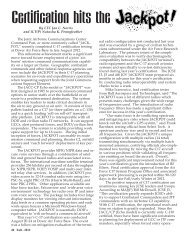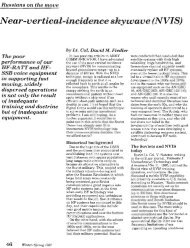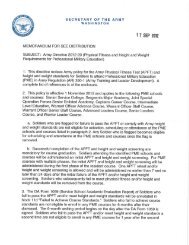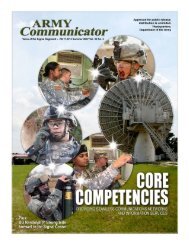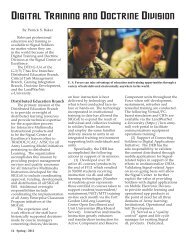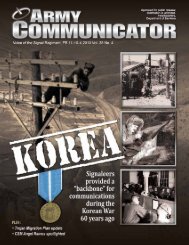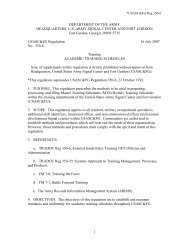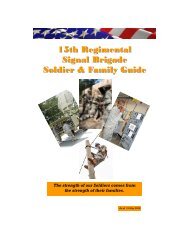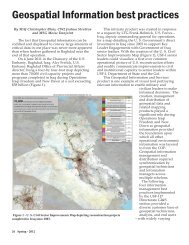AC Summer 08 WIN-T Online - United States Army Signal Center of ...
AC Summer 08 WIN-T Online - United States Army Signal Center of ...
AC Summer 08 WIN-T Online - United States Army Signal Center of ...
Create successful ePaper yourself
Turn your PDF publications into a flip-book with our unique Google optimized e-Paper software.
Battle Command Battle Lab<br />
at Fort Gordon – a rich heritage <strong>of</strong> support to<br />
By Dale A. White<br />
The Capability Development<br />
Integration Development Experimentation<br />
Division, formerly known<br />
as the Battle Command Battle Lab<br />
(Gordon), has a long and proud<br />
history <strong>of</strong> providing support to the<br />
<strong>WIN</strong>-T program. Established in<br />
1992, the BCBL(G) mission is to<br />
conduct experiments and technical<br />
assessments on emerging concepts<br />
and technologies focused on improving<br />
the “means” <strong>of</strong> battle<br />
command. BCBL(G) provides an<br />
unbiased look at technology and<br />
serves as the “honest broker” for<br />
both the acquisition and user<br />
communities. BCBL(G) experimentation<br />
dating back to the late 1990s<br />
has provided valuable insights<br />
regarding communications concepts<br />
and technologies and has produced<br />
prototypes that have directly<br />
transitioned to the fighting force.<br />
Early experimentation<br />
In 1997, a general <strong>of</strong>ficer<br />
memorandum approved the formation<br />
<strong>of</strong> a distributed testbed between<br />
the BCBL(G) and the CECOM<br />
Research and Development Command<br />
Space and Terrestrial Communications<br />
Development as part <strong>of</strong><br />
a collaborative effort to provide risk<br />
mitigation for Program Manager<br />
Warfighter Information Network<br />
(the original name <strong>of</strong> <strong>WIN</strong>-T). The<br />
<strong>WIN</strong> Pro<strong>of</strong>-<strong>of</strong>-Concept testbed<br />
provided a robust experimentation<br />
environment that evaluated emerging<br />
technologies and integrated<br />
those technologies into working<br />
prototypes. As a result, two <strong>WIN</strong><br />
POC nodes were developed, one<br />
mounted on a Humvee and another<br />
in transit cases. Both nodes provided<br />
voice and Internet Protocol<br />
28th CSH JRTC rotation supported by BCBL(G) <strong>WIN</strong> POC node, September 1999.<br />
<strong>WIN</strong> –T<br />
data over an asynchronous transfer<br />
mode wide area network backbone.<br />
In 1999, BCBL(G) deployed the <strong>WIN</strong><br />
POC node to Fort Polk, La., on its<br />
first tactical mission to support <strong>of</strong><br />
the 28th Combat Support Hospital<br />
JRTC rotation.<br />
A 2048 kbps satellite link back<br />
to the BCBL(G) provided Nonsecure<br />
IP Router Network and<br />
Defense Switched Network services<br />
to the hospital staff. More than<br />
3,500 phone calls were made in a 20<br />
day period. The <strong>WIN</strong> POC nodes<br />
participated in several other key<br />
events, most notably the Joint<br />
Contingency Force Advanced<br />
Warfighting Experiment and<br />
Millennium Challenge ’00. The<br />
architecture became the basis for the<br />
six brigade subscriber nodes built by<br />
the CERDEC which were fielded to<br />
the first three Stryker Brigades.<br />
<strong>Army</strong> Communicator 53



